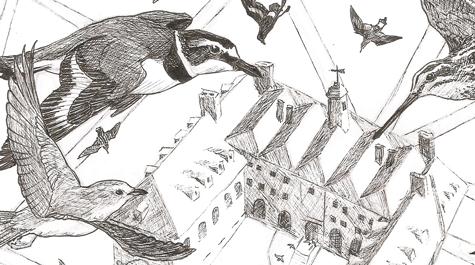Ornithologists, amateur birders will flock together at conference
Ornithologists and bird enthusiasts from around the globe will flock to Williamsburg for a chance to hear from esteemed researchers and mingle with avian royalty.
The Wilson Ornithological Society (WOS) is holding its 125th Annual Meeting March 7-10 at William & Mary. This year’s conference additionally marks the 200th anniversary of the death of Alexander Wilson, the namesake of the society. More species of North American birds are named for Alexander Wilson than any other ornithologist.
William & Mary Professor of Biology Dan Cristol is heading up the organization of the conference, which will feature about 100 presentations and half as many posters. A sizeable group of William & Mary faculty, some of whom are representing both the Center for Conservation Biology (CCB) as well as the Institute for Integrative Bird Behavior Studies (IIBBS,) will present short lectures or posters. These presentations will feature professors’ active research, or in some cases their students’ active research. The highlight of the weekend will be an address by Princeton evolutionary biologists Rosemary and Peter Grant.
The Grants are the famed researchers featured in the Pulitzer Prize-winning book The Beak of the Finch, and are renowned as avian experts due to their 40 consecutive years of intensive work and study of the famous finches of the Galapagos.
“The Grants are particularly impressive because not only are they great scientists who have contributed to absolute top levels of science, but also because they’re very popular figures as well,” says Cristol. “People who aren’t even that interested in birds will come to hear them because they are contributing to evolutionary biology in general, not just the study of birds.”
A Margaret Morse Nice Plenary Lecture will also be given by Edward H. Burtt, Jr. of the Ohio Wesleyan University Department of Zoology on the March 8. The second Margaret Morse Lecture will follow on March 9, featuring the Grants. Participants will also have the opportunity to attend two special symposia featuring multiple presenters on the history of ornithology as well as the relationship between birds and human health.
“In all, there are 30 abstracts for talks and posters that have at least one author from William & Mary, which is quite an astounding testament to the amount of bird research going on here,” says Cristol. There will also be a serious influx of researchers from far outside the William & Mary community, he added.
“Approximately 250 scientists from at least as far away as Manitoba and Mexico will be migrating to the Sadler Center,” says Cristol. Cristol has personally encouraged professors and their students in the ornithology realm from all over Virginia to attend.
“This meeting has been designed to have some public outreach to the community for the whole state of Virginia,” says Cristol. The conference welcomes hobbyist or otherwise amateur birders, offering access to receptions, banquets, vendors and field trips.
There will be a birding field trip to observe local species before the plenary talks on both Friday and Saturday, as well as five excursions on Sunday including to the sites of Virginia’s recovering red-cockaded woodpecker population, the waters around the Chesapeake Bay-Bridge Tunnel and Chincoteague National Wildlife Refuge.
 Skip to main content
Skip to main content

